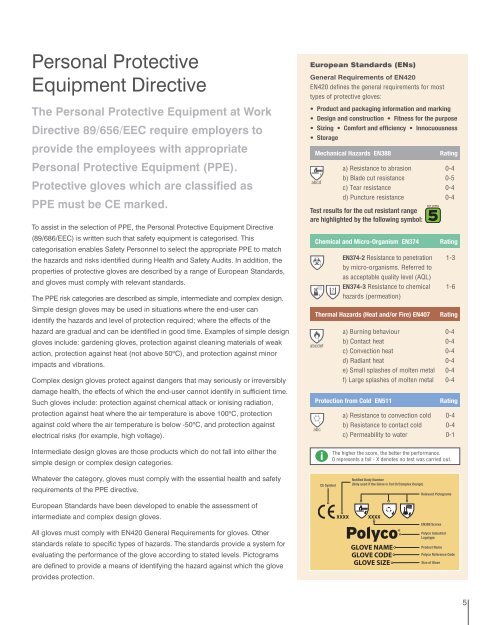BM Polyco Puncture Resistant Gloves - Catalogue - Reid Brothers
BM Polyco Puncture Resistant Gloves - Catalogue - Reid Brothers
BM Polyco Puncture Resistant Gloves - Catalogue - Reid Brothers
You also want an ePaper? Increase the reach of your titles
YUMPU automatically turns print PDFs into web optimized ePapers that Google loves.
Personal ProtectiveEquipment DirectiveThe Personal Protective Equipment at WorkDirective 89/656/EEC require employers toprovide the employees with appropriatePersonal Protective Equipment (PPE).Protective gloves which are classified asPPE must be CE marked.To assist in the selection of PPE, the Personal Protective Equipment Directive(89/686/EEC) is written such that safety equipment is categorised. Thiscategorisation enables Safety Personnel to select the appropriate PPE to matchthe hazards and risks identified during Health and Safety Audits. In addition, theproperties of protective gloves are described by a range of European Standards,and gloves must comply with relevant standards.The PPE risk categories are described as simple, intermediate and complex design.Simple design gloves may be used in situations where the end-user canidentify the hazards and level of protection required; where the effects of thehazard are gradual and can be identified in good time. Examples of simple designgloves include: gardening gloves, protection against cleaning materials of weakaction, protection against heat (not above 50ºC), and protection against minorimpacts and vibrations.Complex design gloves protect against dangers that may seriously or irreversiblydamage health, the effects of which the end-user cannot identify in sufficient time.Such gloves include: protection against chemical attack or ionising radiation,protection against heat where the air temperature is above 100ºC, protectionagainst cold where the air temperature is below -50ºC, and protection againstelectrical risks (for example, high voltage).European Standards (ENs)General Requirements of EN420EN420 defines the general requirements for mosttypes of protective gloves:• Product and packaging information and marking• Design and construction • Fitness for the purpose• Sizing • Comfort and efficiency • Innocuousness• StorageMechanical Hazards EN388abcdabcdefabca) Resistance to abrasion 0-4b) Blade cut resistance 0-5c) Tear resistance 0-4d) <strong>Puncture</strong> resistance 0-4Test results for the cut resistant rangeare highlighted by the following symbol:Chemical and Micro-Organism EN374EN374-2 Resistance to penetration 1-3by micro-organisms. Referred toas acceptable quality level (AQL)EN374-3 Resistance to chemical 1-6hazards (permeation)Thermal Hazards (Heat and/or Fire) EN407Ratinga) Burning behaviour 0-4b) Contact heat 0-4c) Convection heat 0-4d) Radiant heat 0-4e) Small splashes of molten metal 0-4f) Large splashes of molten metal 0-4Protection from Cold EN511RatingRatingRatinga) Resistance to convection cold 0-4b) Resistance to contact cold 0-4c) Permeability to water 0-1Intermediate design gloves are those products which do not fall into either thesimple design or complex design categories.iThe higher the score, the better the performance.0 represents a fail - X denotes no test was carried out.Whatever the category, gloves must comply with the essential health and safetyrequirements of the PPE directive.European Standards have been developed to enable the assessment ofintermediate and complex design gloves.All gloves must comply with EN420 General Requirements for gloves. Otherstandards relate to specific types of hazards. The standards provide a system forevaluating the performance of the glove according to stated levels. Pictogramsare defined to provide a means of identifying the hazard against which the gloveprovides protection.CE SymbolNotified Body Number(Only used if the Glove is Cat III/Complex Design)Relevant PictogramsEN388 Scores<strong>Polyco</strong> IndustrialLogotypeProduct Name<strong>Polyco</strong> Reference CodeSize of Glove5


